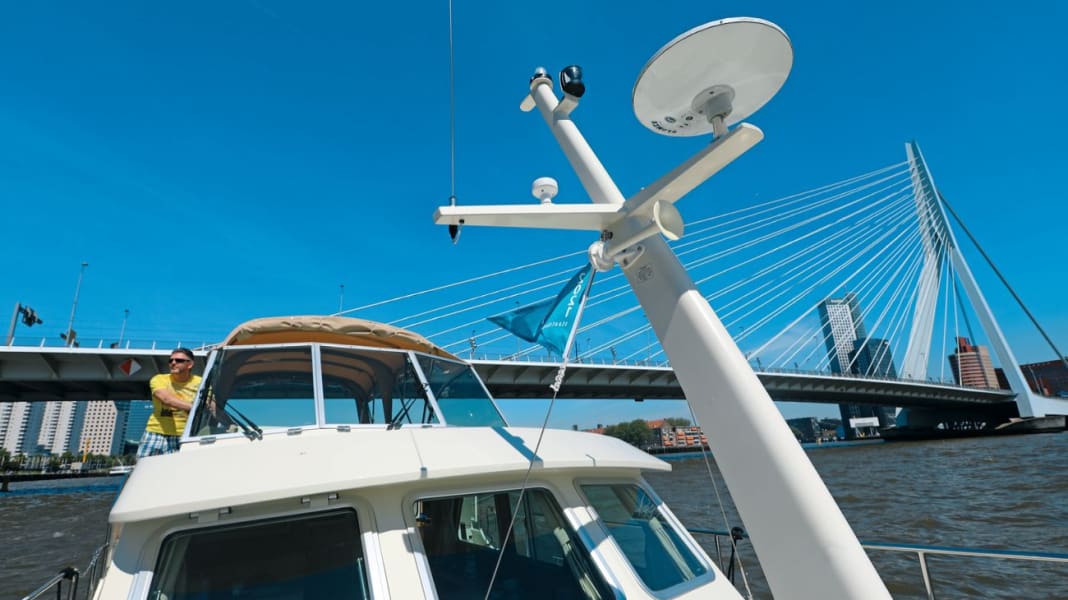
The street decorations in the more touristy part of Gouda, between Nieuwe Markt and Kattensingelgracht, are to be understood figuratively: The city's "gold" is not just piled up in the shop windows, it hovers above everything. Whole wheels of cheese hang from steel cables stretched across the streets. They dangle in the blue sky like little suns. They look very real. A few Americans get ready for a selfie underneath. The message on the round labels: "Gouda. Cheese Capital of the World". They understand that at home. Cheese capitals of the world are also known in the land of unlimited superlatives - and even have several of their own. Tillamook in Oregon, for example. Or Plymouth in Wisconsin. It is no coincidence that the football fans of the nearby Green Bay Packers are known as theCheeseheadslabelled. Part of their stadium outfit is a corresponding headgear full of holes. Of course, European travellers from overseas know that the beautiful titles at home are more or less self-awarded.But Goohda, it's real!
The small town with the world-famous name simply makes every visitor happy. We are no exception. There is also the very normal Gouda, which treats its status very casually, with a likeable mixture of pride and self-irony. And of course you can also find the real thing, not only in the countless speciality shops, but also at the centuries-oldkaasmarkt. You can find everything there, from industrial producers to small organic farmers, young and old, in all colours, shapes and varieties: with cumin, liquorice or white beer? There is nothing that is not available. It's hard to decide. In the end, my colleague René and I each bring more than one flavour back to the boat waiting for us in Turfsingelgracht. But we're not even halfway through our charter trip through the province of Zuid-Holland - and a piece of cheese is always a good idea.
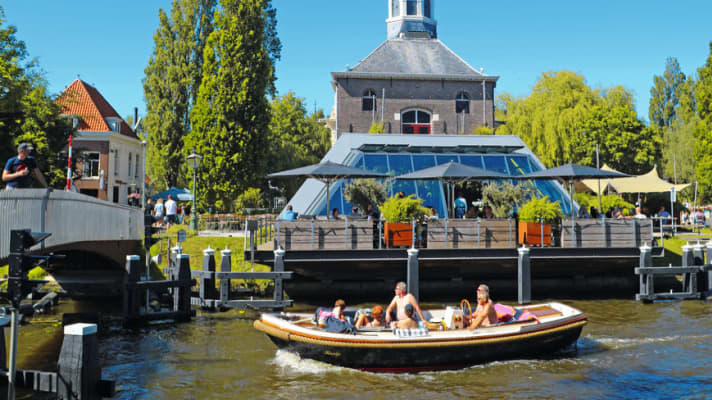
"It's best to do Rotterdam at the end," advises Paul-Michiel from Dutch Yacht Rentals. "Because that's when it really gets down to business." Three days earlier, the three of us are standing around the table on the aft deck of "Stella", a Linssen Grand Sturdy 35.0 AC, with which we want to explore the west of the Netherlands in the coming week. Spread out in front of us are three folding maps covering the area. We were already here in Willemstad last year. Back then, the charter base in Jachthaven De Batterij was the starting point for a trip to Zeeland in the south (see BOOTE issue 2/21). This time it will be the other way round, Zuid-Holland is our turn, once anti-clockwise. We are hoping for exciting contrasts between the old and the new. Just like last year, Corona has fortunately at least largely gone into the summer break, and the relief is palpable everywhere. It's the middle of June - but summer is already here.
The Hollands Diep is one of the motorways in the Dutch waterway network. It unites the southern estuary of the Rhine and the Meuse. A branch, the Dordtsche Kil, also shortens the distance from Rotterdam to Antwerp. It goes without saying that there is a lot of traffic between Europe's largest seaports. Wherever possible, we keep outside the buoy line. Tankers and motorised cargo vessels overtake us with impressive bow waves. They are Dutch, Belgian and German, single drivers and convoys, loaded with liquid gas, ballast or containers. They are all in a hurry. After passing the smoking chimneys of Moerdijk on our starboard side, we wait for a gap in the traffic and cross the Hollands Diep to the mouth of the Dordtsche Kil.
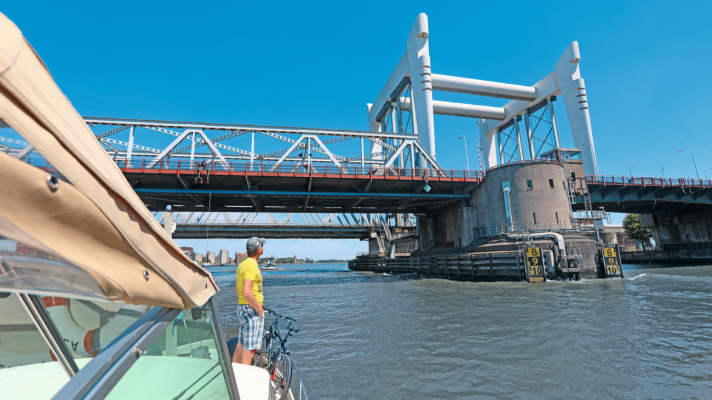
On the next eight kilometres to the north, things get tight. There is hardly any space left between the edge of the fairway and the embankment, especially shortly after low water. About halfway along the route, we are overtaken by a bilge oiler, which in turn is overtaken by an empty 135-metre tanker. At the same time, a push boat with a mountain of containers in front of the bow - and a good blind spot - comes in from the front. Nothing is happening on VHF channel 10. Everything seems to be quite normal.
Dense buildings soon rise up behind the dyke line, with the roofs of 's-Gravendeel on the left and large warehouses and sheds on the right. Shortly afterwards, the Dordtsche Kil meets the Oude Maas. We turn to starboard, past the harbour entrance to Dordrecht, which is our destination for today. As pleasure craft are much more comfortable here further north in the centre, we sail a few more kilometres, now in a completely urban environment, until we have also passed the striking railway lift bridge, which is still high enough for us even when closed. The Boombrug, an old bascule bridge, is a different story. It blocks our access to the Wijnhaven, one of the three historic basins that have long been too small for commercial use. Although the bridge has fixed opening hours, we prefer to report in by radio. While we wait, the waterbuses shoo us back and forth, commuting at high speed to Rotterdam and emphasising their right of way with loud howls. Just in time, the signal at the bridge changes from red to red-green and finally to green. We enter the harbour, moor at the reporting jetty and get a place on the floating dock.
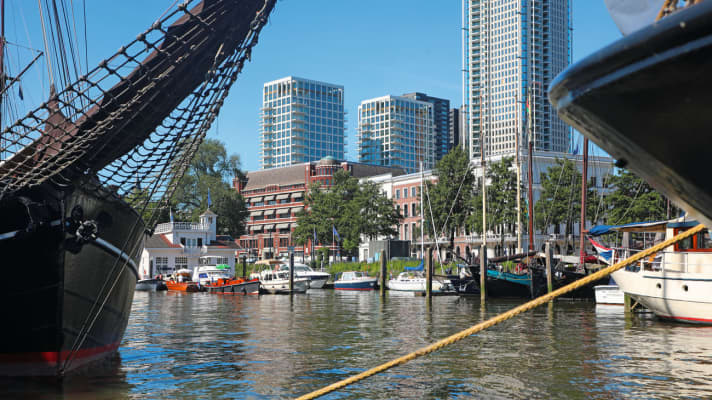
After a visit from the harbour master, we set off on foot into the city. We cross the Boombrug, take a look through the archway of the Groothoofdspoort with its rich coat of arms decoration and arrive at the Wolvewershaven, where former cargo-carrying flat bottoms with heavy side swords and steam tugs remind us of a bygone era in Dotdrecht. Continue to the late medieval Grote Kerk, whose tower is already leaning slightly. We actually wanted to climb this magnificent example of Brabant Gothic architecture, which is typical of the Netherlands. The 275 steps would have given us a great overview of Holland's oldest city. Unfortunately, the coronavirus has put a spanner in the works.
Off to Gouda! From the Oude Maas, we first head north on the busy Noord. A patrol boat from Rijkswaterstaat, the supervisory and administrative authority responsible for the waterways, shoots past with its blue lights flashing at high speed and creates quite a wave under the Alblasserdam bridge. Finally, we come out onto the Nieuwe Maas, the middle estuary of the Rhine. But we only follow its wide course downstream for a short distance. As soon as we reach Krimpen, we leave it to the north-east, and the skyline of Rotterdam, already visible, slowly disappears again to the stern. How quiet it suddenly is!
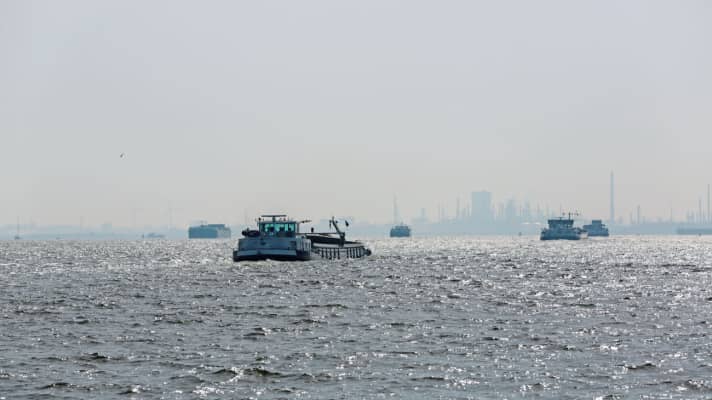
We still have about twenty kilometres to go on the Hollandse IJssel. We cross the open Algerasluis, which serves as protection against storm surges. Behind Capelle, flat polders stretch out on both sides of the river, which in turn is bordered by high dykes. We have almost reached our destination in the early afternoon. While the Hollandse IJssel swings eastwards, we have to continue northwards on the confluent Gouwe. We register at the waiting jetty in front of the Julianasluizen and are allowed to enter just behind a barge. Now it's time to enter the Nieuwe Gouwe, but then the Steve Bikobrug shows double red: it's broken and therefore impassable. How long will the closure last? A few days, is the answer. At least the cruising guide knows that there is a second way into the city, from the south via Hollandse IJssel and the old Mallegatsluis. The entrance to the harbour only has enough room for us when the tide is low, but the time is right. Even if we have to pass through the Julianasluizen again. Less than an hour later, we moor at the Turfsingelgracht in the centre of Gouda.
Narrow alleyways and water, shady corners and sunny squares, stepped gables and large windows overlooking the street. We make a note of the fish market with its Doric porticoes directly on the Gouwe for later. Now we want to go to the Goudse Waag behind the old town hall on the market square. For centuries, merchandise was weighed on the ground floor of the building, which was opened in 1670, so that it could be taxed before being sold. This included cheese - which producers from the surrounding area were only then allowed to sell as "Gouda". Its history, including its triumphal march around the globe (which had a lot to do with its proximity to the major seaports), is told in the attic, which has been converted into a museum. For example, what the "maturity test" is all about: there are seven age groups, fromjong (four weeks) untiloverjarig (one year and older). It's a little like real life: Freshness is fleeting, but character grows stronger.
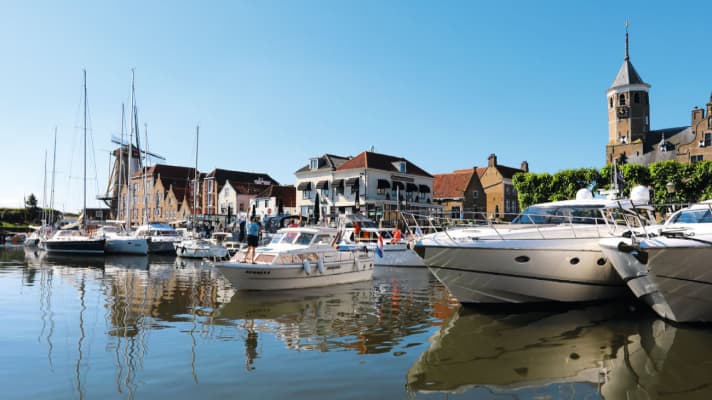
Young and old also play a role at our next destination for the day, the university city of Leiden. The Gouwe leads us northwards through flat, wide open countryside past Waddinxveen and Boskoop. In Alphen, after fifteen kilometres, we meet the Oude Rijn, which we now follow westwards for the same distance. The river takes us right into the centre to the Passantenhaven. This is a dead end for large yachts like our Linssen, and we will have to turn back a little and then southwards to continue our journey tomorrow. However, this doesn't apply to the countless sloops and pleasure craft that fit under the bridges in the old town centre. It's amazing what's going on on the water! What floats is full of people, with sun hats and picnic baskets or naked torsos and crates of beer on board. The onset of dusk does nothing to change this: as the bars and restaurants at the confluence of the Oude and Nieuwe Rijn fill up more and more, the navigation lights glide past like an endless chain of lights.
The last stage to Rotterdam the next day is almost never over open fields. Usually at least one side is built on, often both. On the first section of the Rijn-Schiekanaal, also known as the Vliet, this is mainly due to The Hague. The canal runs through the suburbs of Leidschendam (with lock), Voorburg and Rijswijk. There is a lot to see here that looks like an upmarket lifestyle. No wonder, as the city of half a million inhabitants is not only the political centre of the country, but also the seat of the royal family. There are also many bridges, too many to mention. In Delft in particular, which connects to The Hague to the south, the traffic is so dense that it is better to save individual entries in the logbook. Apart from that, the passage is not a problem: some bridges are high enough even when closed, some have to be signalled. If there are any waiting times, they are usually limited.

Shortly after the Delftse Schie, as the last canal section south of Delft is called, reaches Rotterdam, the five parallel basins of the Delfshaven are passed on starboard. From here onwards, more inland waterway vessels are travelling again. After the Beukelsbrug at the latest, you find yourself in the centre of the city, with passers-by on the riverside promenade, road traffic and the long, red-brick façades of the residential buildings on Spangese- and Aelbrechtskade, before the canal makes a final S at Coolhaven. Now through the small chamber of the Parksluizen, and in the shadow of the Euromast with its one hundred metre high viewing platform, the inland trip releases us back onto the tidal, free-flowing Nieuwe Maas.
No berth could be better suited to the Rotterdam experience than the Veerhaven: this is where yesterday meets tomorrow, tradition meets vision. Historic sailing ships, modern yachts, the Art Nouveau style around the rectangular basin and the soaring glass facades of the tower blocks behind create a unique atmosphere. During the war, the city, which had been badly damaged by German bombs, lost much of its appearance. It took time for it to regain its former economic strength - and even reinvent itself in some respects. The Rotterdam of today looks back and forward at the same time. Nowhere is this more evident than on the waterfront opposite: There, industrial sites that have been disused for years on the Rijn and Maashaven harbours are being transformed into a new living environment for the 21st century - but not without leaving the traces of its own past clearly visible as part of the whole. The way there leads via the iconic Erasmus Bridge. It is named after the humanist Erasmus of Rotterdam. The city's most famous son lived half a millennium ago. Old and young come together here too.
Need more information? You will find the travel report "Young and Old" with further pictures and area data in BOOTE issue 01/2022 from 15.12.2021 at the kiosk or online in the Delius Klasing Shop.

